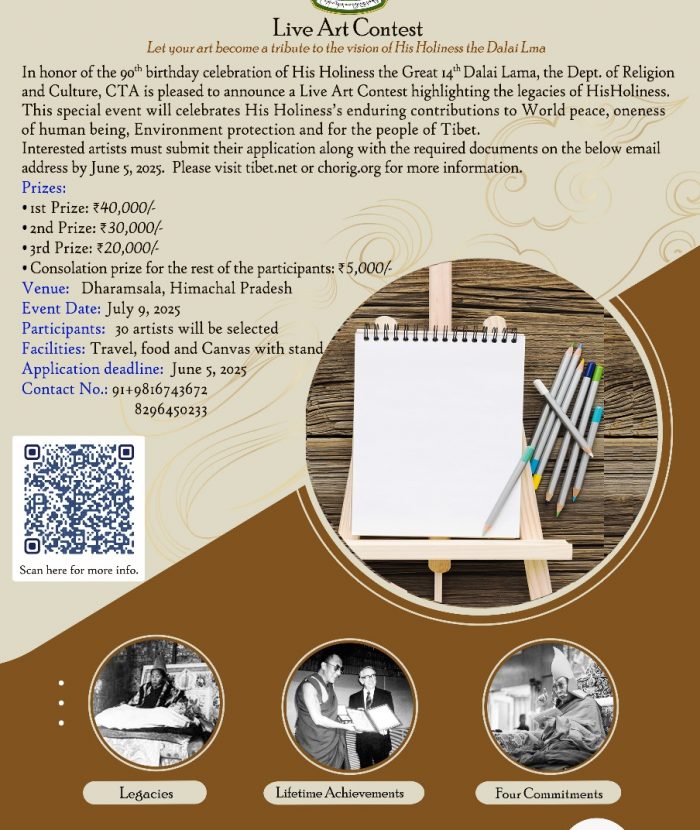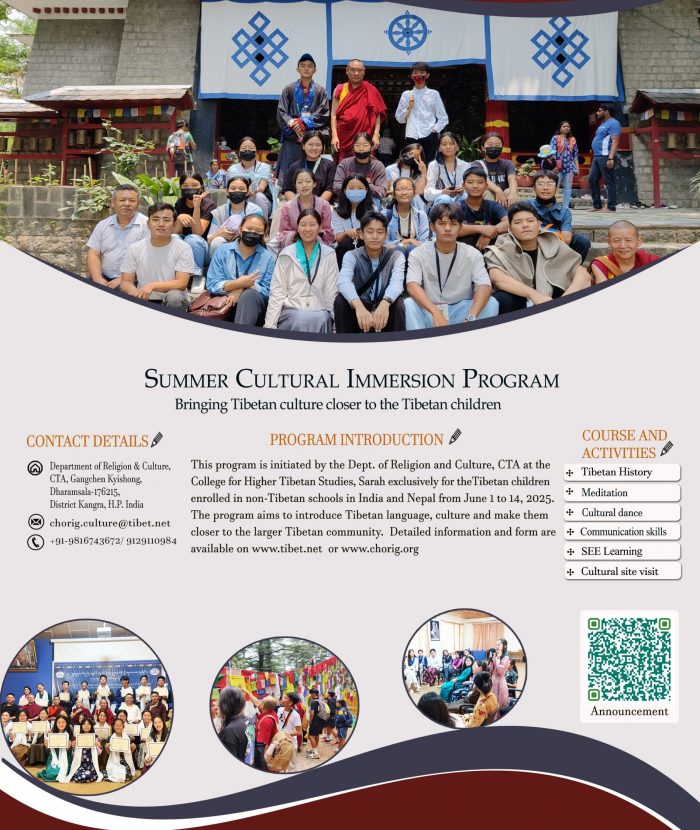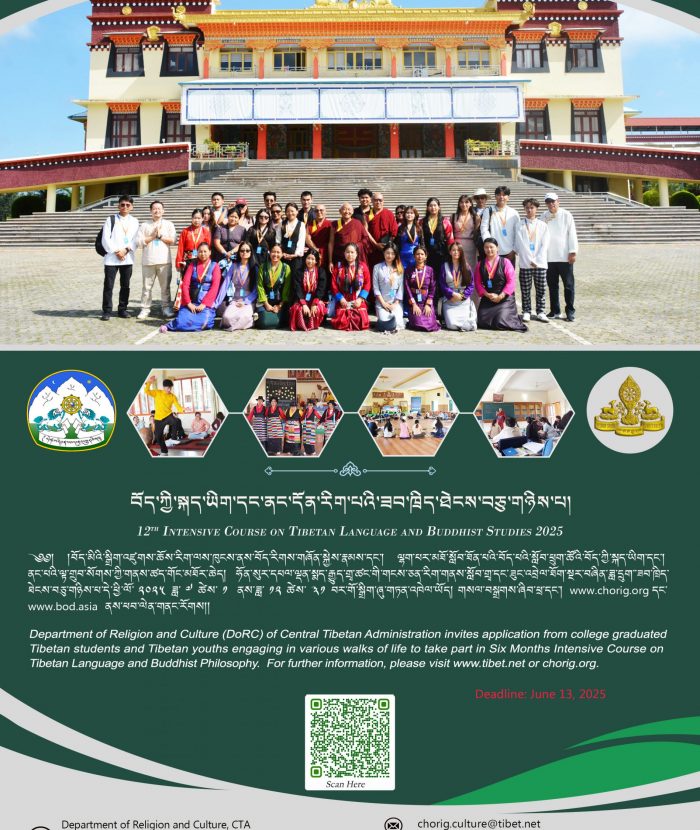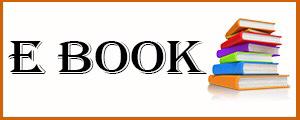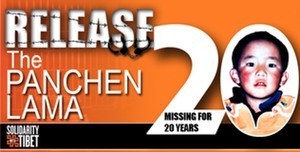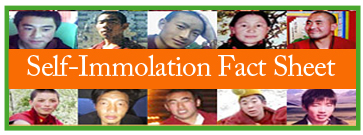The Nyingma school of Tibetan Buddhism traces its origin to the Indian adept, Guru Padmasambhava, who came to Tibet in 817 C.E. at the invitation of King Trisong Deutsan (742-797) in order to subdue the evil forces then impeding the spread of Buddhism. Guru Rinpchey, as he is popularly known, bound all evil spirits by oath and transformed them intor forces compatible with the spread of Buddhism. In collaboration with the great Bodhisattva Abbot Shantarakshita, Guru Rinpochey then built Samyey monastery, which became a principal centre of learning and the site where many of the texts that would make up Tibet’s vast Buddhist literature were first translated into Tibetan.
Guru Rinpchey also gave widespread teachings from the highest classes of tantra and in particular to his twenty-five principal disciples. These first Tibetan adepts are renowned for their spiritual accomplishments, for example, Namkhe Nyingpo for his feat of traveling on beams of light, Khandro Yeshe Tsogyal for reviving the dead, Vairochana for his intuition, Nanam Yeshe for soaring in the sky, Kawa Peltseg for reading others’ thought and Jnana Kumara for his miraculous powers.
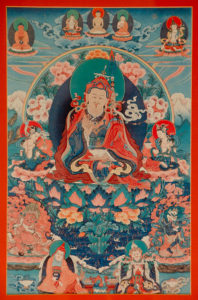
Contemporary Indian masters Vimalamitra,Buddhaguhya, Shantipa and the tantric adept, Dharamkirti, also came to Tibet and spread tantric teachings. So, although the study of logic and Buddhist philosophy was not yet prevalent, the practice of tantra in extreme secrecy was much favoured. Even the work of translating such esoteric texts as Kun-byed rgyal-po, mDo-dgongs-‘dus and ht Mahamaya cycle of teachings by Vairochana, Nyag Jnana Kumara, Nubchen Sangye Yeshe and others, was carried out in great secrecy.
Seeing the disciples unripe and the time inappropriate for many of the other teachings he had to reveal, Guru Padmasambhava hid hundreds of Treasures in the forms of scriptures, images and ritual articles, with instructions for their revelation for the benefit of future generations. Subsequently, more than one hundred masters have revealed these Treasures and taught them to their disciples. So, besides the tantric teachings, it is these lineages of revealed teachings combined with the Great Completion or Dzogchen doctrine taught and disseminated sucessively by Garab Doyjer, Shri Simha, Guru Rinpochey, Jnana Sutra, Vimala Mitra, which are distinguished in Tibet as Nyingma doctrine.
The Nyingma tradition divides the entire Buddhist teaching into Nine Vehicles : the three Common Vehicles comprising the Hearer, Solitary Realizer, and Bodhisattva vehicles dealing with those categories of teachings included in the sutras taught by Buddha Shakyamuni; the Three Outer Tantras consisting of Kriya Tantra which places greater emphasis on practicing proper external behaviour, physical and verbal conduct aimed at purification and simple visualization practice; Upa Tantra which lays more emphasis on developing both external and internal faculties with the goal of achieving a deeper affinity with the meditational deity; and Yoga Tantra, which is mainly aimed at developing the strength of inner psychophysical vitality as taught by Vajrasttva. Finally, the Three Innermost Tantras comprising Mahayoga, primarily emphasizing the Generation Stage practice in which the ordinary level of perception and attachment are eliminated through sacred vision and divine pride; the Annuyoga, emphasizing Completion Stage practice in which the vajra body is used as a serviceable means to actualize primordial awareness and the Atiyoga, in which all emphasis is directed towards full activation of the generation and completion stage practices, enabling the yogi to transcend all ordinary time, activity and experience, as taught by Samantabhdra Buddha. [expander_maker id=”1″ more=”Read more” less=”Read less”]
The first six of these nine vehicles are common to all schools of Tibetan Buddhism, whereas the last three, the Innermost Tantras, are exclusive to the Nyingma tradition.
Due to the slightly different approaches of various lineages in presenting Dzoghcen three sub-schools have developed: the Mind School (Sems-sde) is attribute to Shrisimha and Vairochana’s lineage, the Centredness School (kLong-sde) is attributed to Longde Dorje Zampa, and Shrisimha and Vairochana’s lineage, whereas the Quintessential Instruction School (Man-ngag-sde) is attributed directly to Guru Padmasambhava’s lineage of the Heart’s Drop (sNying-thing) cycle of teaching and practice.
ReadMore
Although Dzogchen is the unique feature of Nyingma practice, even among the lay followers the practice of reciting Guru Rinpochey’s prayers, observing the 10th and 25th of every lunar month as a day for feast offerings, and even retiring into retreat for three years and three months individually or in company are common.
According to the history of the origin of tantras there are three lineages : The Lineage of Buddha’s Intention, which refers to the teachings of the Truth Body originating from the primordial Buddha Samantabhadra, who is said to have taught tantras to an assembly of completely enlightened beings emanated from the Truth Body itself. Therefore, this level of teaching is considered as being completely beyond the reach of ordinary human beings. The Lineage of the Knowledge Holders corresponds to the teachings of the Enjoyment Body originating from Vajrasattva and Vajrapani, whose human lineage begins with Garab Dorje of the Ogyan Dakini land. From him the lineage passed to manjushrimitra, Shrisimha and then to Guru Rinpochey, Jnanasutra, Vimalamitra and Vairochana who disseminated it in Tibet. Lastly, the Human Whispered Lineage corresponds to the teachings of the Emanation Body, originating from the Five Buddha Families. They were passed on to Shrisimha, ཝho transmitted them to Guru Rinpochey, who in giving them to Vimalamitra started the lineage which has continued in Tibet until the present day.
This last mode of transmission is most commonly employed for ordinary people. However, the former two lineages may still exist amongst the highly realized Dzogchen masters.
There is yet another tradition which enumerates six lineages for the origin of the trantras by adding: the Commissioned Instruction Lineage (bK’a-bab lung-bstan-gyi-brgyud-pa), the Treasure Doctrine Lineage of the Fortunate One’s (Las-‘phro gtser-gyi-brgyud-pa) and the Lineage of Trustees Established through Prayers (sMOn-lam gtad-rgya’i-bragyud-pa).
The Nyingma tantric literature and its transmission is classified into three groups: the Oral, Treasures, and Vision. These three may be further subsumed under two categories: the Oral comprising primarily the tantras and associated texts belonging to the cycle of Mahayoga tantras; the root and explanatory tantra belonging to the cycle of Annuyoga tantras; and finally, the Atiyoga or Dzogchen cycle of tantras.The Treasure transmission comprises the innumerable treasure texts revealed by subsequent Treasure Masters, which were hidden by Guru Rinpochey himself in 9th century as well as numerous teaching later revealed through enlightened minds and meditative vision s of Nyingma masters. Hundreds of masters have appeared who have revealed treasures. Among them, Nyangral Nyima Ozer (1124-92), Guru Chowang (1212-70), Dorje Lingpa (1346-1405), Padma Lingpa (b. 1405) and Jamyang Khyentse (1820-1892) are renowned as the Five Kings of the Treasure Masters. Their revealed treasures concern, among others, the cycle of teachings and meditations related to Avalokiteshvara, Guru Rinpochey’s sadhanas, the Dzogchen teachings, the Ka-gyey cycle of teachings, the Vajrakila or Phurba cycle of teachings, medicine and prophecies.
Hence, in addition to the standard Mahayana Buddhist canon of the Kangyur and Tangyur, many further teachings may be found in the Collection of a Hundred Thousand Nyingma Tantras, compiled in thirteenth century by Terton Ratna Lingpa (1403-1473) and organised by Kunkhyen Longchen Ramjampa (1308-1363). Besides this, numerous works such as the sixty volumes of the Rinchen Terdzod compiled by Kongtrul Yonten Gyatso (1913-1899) and the writings of Rongzom, Dodrupche, Paltrul, Mipham and many othes have added to the rich collection of Nyingma literature. The oldest Nyingma institution is Samyey temple completed in 810 C.E by Shantarakshita and Guru Padmasambhava under the patronage of King Trisong Deutsan. Subsequently, no big monasteries were built until the 12th century, when Nechung Monastery was built in central Tibet by Chokpa Jangchub Palden and Kathok Monastery was founded in Kham by Ka Dampa Desheg (1112-92) in 1159. This is an indication that unlike the other Buddhist traditions the Nyingmapas did not become institutionalized until much later in their history. From the 15th century onwards, great monastic universities were built such as Mindroling, founded in 1676 by Rigzin Terdag Lingpa, otherwise known as Minling Terchen Gyurmed Dorje (1646-1714) and Dorje Drag found in 1659 by Rigzin Ngagi Wangpo in central Tibetan; and Palyul established by Rigzin Kunsang Sherab in 1665; Dzogchen built by Dzogchen Pema Rigzin in 1685 and Zhechen establishd by Zhechen Rabjampa in 1735, all in Kham province. Dodrupchen and Darthang monasteries were established in Amdo.
Principal monastic institutions re-established in exile are Thekchok Namdrol Shedrup Darbye Ling, in Bylakuppe, Karnataka State; Ngedon Gatsel Ling, in Clementown, Dehradun; Palyul Chokhor Ling and E-Vam Gyurmed Ling in Bir, and Nechung Drayang Ling at Dharamsala, and Thubten E-vam Dorjey Drag at Shimla in Himachal Pradesh, India.
The Nyingma tradition is presently headed by Dilgo Khyentse Rinpochey, who succeds Kyabje Dudjom Rinpochey (1904?-1987). Besides, Minling Trichen Rinpochey, Trulzhig Rinpochey, Taglung Tsetrul Rinpochey and Penor Rinpochey are some of the living spiritual masters.
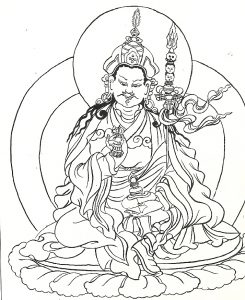
Less

